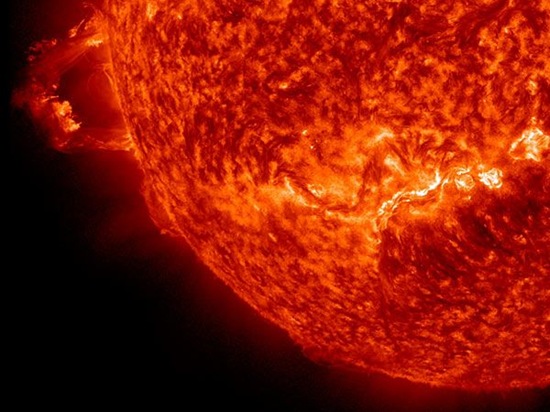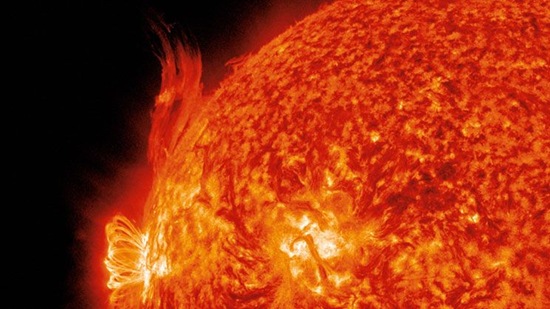
Solar "Tsunami": Giant Double Sun Eruption Caught on Video
By Kate Andries, National Geographic News, 19 November 2012.
By Kate Andries, National Geographic News, 19 November 2012.
A virtual solar tsunami was caught on video early Friday morning, with back-to-back solar arcs so large that NASA's cameras couldn't capture the explosions in their entirety.
NASA Video: November 16 Double Solar Prominence
NASA's space-based Solar Dynamics Observatory (SDO) recorded the images over a four-hour period. The giant loops, called solar prominences, occurred between 1 a.m. and 5 a.m. ET on Friday.
Many times larger than the entire Earth, the prominences were so large that they expanded beyond the high-definition camera view of the SDO. (See some of SDO's first sun pictures.)
In the video, hot waves of charged gas - released when tangled solar magnetic fields destabilized and exploded before reconnecting again - arc away from the sun in vast red loops, according to NASA's Goddard Space Flight Centre.
Sun Now at Its Most Active
Both solar prominences will likely have little to no effect on Earth, as they don't appear to be aimed toward the planet.
These giant arcs are the latest in a series of increasing eruptions on the sun as its 11-year cycle of magnetic fluctuations - a time of periodic change in the sun's activity and appearance - nears its peak.
Earlier last week a moderate flare was seen on November 12 and later caused a geomagnetic storm above Earth, resulting impressive northern lights displays by supercharging the Earth's auroras.
Known as a solar maximum, the peak of a cycle sees an increase in sunspots and large solar flares and prominences. Solar maximums can last a couple of years, said Leon Golub, senior astrophysicist at the Harvard-Smithsonian Centre for Astrophysics.
"We are in the peak of the cycle right now," Golub said. "The sun is in its most active state." (Related: "Solar Flare Sparks Biggest Eruption Ever Seen on Sun.")
Solar Storms Could Zap Modern Life
This peak could have serious consequences for the electrical grid that surrounds the Earth: Solar flares and prominences, when aimed at the planet, have the potential to disrupt electrical systems and satellites.
"Every technological aspect of our society can be affected by these events," Golub said. "Satellites can be damaged; astronauts can receive a lot of radiation."
The most damaging emissions from big solar storms travel slowly enough to be detected by satellites well before the particles strike Earth, Tom Bogdan, director of the U.S. Space Weather Prediction Centre in Boulder, Colorado, told National Geographic News in 2011 (see "What If Biggest Solar Storm on Record Happened Today?").
Scientists are working toward a better way to predict and prevent the damaging effects of a solar storm on Earth.
"We have satellites in space now that can detect these events sooner and better than ever before," the Smithsonian's Golub said. "What we're trying to do is predict which ones to worry about, which ones might be damaging."


No comments:
Post a Comment
Please adhere to proper blog etiquette when posting your comments. This blog owner will exercise his absolution discretion in allowing or rejecting any comments that are deemed seditious, defamatory, libelous, racist, vulgar, insulting, and other remarks that exhibit similar characteristics. If you insist on using anonymous comments, please write your name or other IDs at the end of your message.